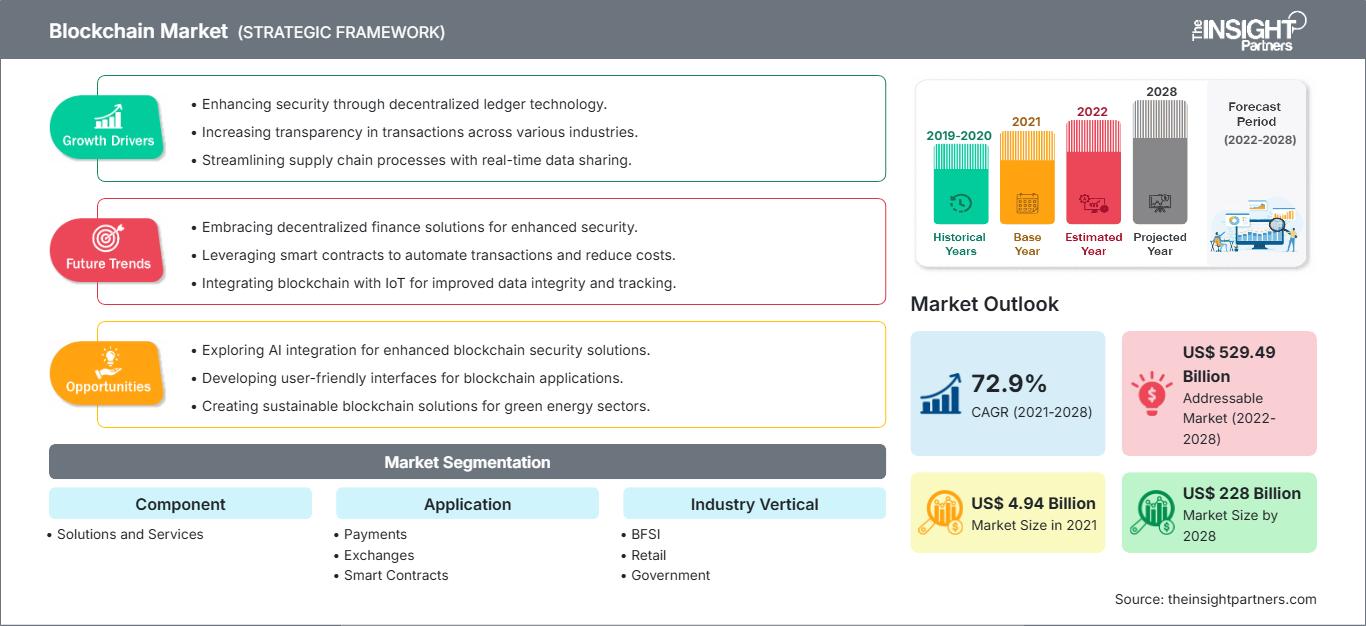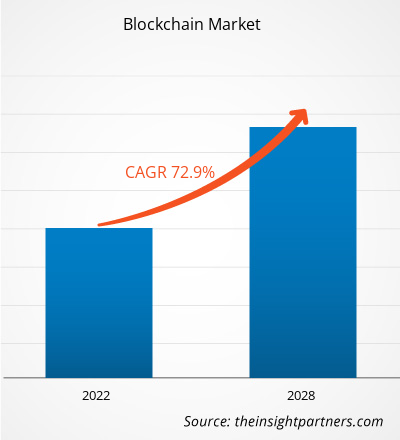Si prevede che il mercato della blockchain crescerà da 4.935,0 milioni di dollari nel 2021 a 227.996,6 milioni di dollari entro il 2028; si stima una crescita a un CAGR del 72,9% dal 2021 al 2028. La tecnologia blockchain e le sue applicazioni nel settore bancario, dei servizi finanziari e delle assicurazioni (BFSI) hanno attirato molta attenzione negli ultimi anni, principalmente per la sua capacità di trasformare le fondamenta e i modelli di business dei settori esistenti. Attualmente, a parte le applicazioni di criptovaluta, le altre principali applicazioni pratiche della blockchain sono ancora nel settore bancario e finanziario; tuttavia, diverse aziende e istituzioni stanno rapidamente sviluppando soluzioni basate sulla blockchain per risolvere problemi aziendali complessi. In termini generali, la blockchain è un sottoinsieme di una più ampia tecnologia di registro distribuito (DLT) e combina tre concetti significativi: crittografia, contratti intelligenti e progettazione di registri distribuiti. La tecnologia di registro distribuito (DLT) è un approccio in rapida ascesa che registra e condivide dati su diversi archivi/registri dati. La DLT facilita la registrazione, la condivisione e la sincronizzazione di transazioni e dati su una rete distribuita di diversi partecipanti.
Si prevede che il mercato globale della Blockchain registrerà una crescita molto elevata nel prossimo futuro. I principali fattori trainanti che contribuiscono alla crescita del mercato includono l'ampia adozione di soluzioni Blockchain nel settore BFSI; vantaggi quali maggiore trasparenza, maggiore efficienza operativa e notevoli risparmi sui costi; e un aumento del numero di startup innovative. Durante il periodo di previsione, si prevede che tendenze come il crescente supporto e le iniziative governative e una combinazione di Blockchain e intelligenza artificiale per applicazioni avanzate offriranno interessanti opportunità per gli operatori che operano nel mercato della Blockchain.
Personalizza questo rapporto in base alle tue esigenze
Potrai personalizzare gratuitamente qualsiasi rapporto, comprese parti di questo rapporto, o analisi a livello di paese, pacchetto dati Excel, oltre a usufruire di grandi offerte e sconti per start-up e università
Mercato Blockchain: Approfondimenti strategici

- Ottieni le principali tendenze chiave del mercato di questo rapporto.Questo campione GRATUITO includerà l'analisi dei dati, che vanno dalle tendenze di mercato alle stime e alle previsioni.
Impatto della pandemia di COVID-19 sul mercato della blockchain Sebbene la pandemia di COVID-19 abbia posto problemi significativi per le organizzazioni di tutto il mondo, il mercato della blockchain è cresciuto costantemente durante la crisi. Soprattutto, durante l'epidemia, gli operatori sanitari hanno iniziato a utilizzare chat, e-mail, telefoni e videoconferenze per curare i pazienti da remoto, prevenendo la diffusione del virus. L'uso di strumenti di penetration testing per transazioni online sicure e dati conversazionali è aumentato di conseguenza. L'adozione del mercato della blockchain da parte di diverse aziende per garantire una sicurezza ottimale in un contesto caotico è anche un elemento cruciale che guida il mercato verticale della blockchain. La pandemia di COVID-19 ha avuto un impatto su tutti gli aspetti della società, compresi individui e aziende. L'ecosistema di Internet è diventato sempre più importante a livello globale. La dipendenza dalle imprese online è aumentata drasticamente a causa dell'epidemia di COVID-19. Internet viene utilizzato da BFSI, sanità e scienze della vita, produzione, vendita al dettaglio, trasporti e logistica e altri settori per fornire servizi essenziali ai consumatori. La domanda di blockchain è aumentata vertiginosamente tra i fornitori. Diversi governi e agenzie di regolamentazione hanno costretto organizzazioni pubbliche e private ad adottare nuove tecniche di telelavoro e di mantenimento del distanziamento sociale a seguito della pandemia di COVID-19. Da allora, le pratiche commerciali digitali e l'utilizzo della posta elettronica su server domestici sono diventati il nuovo piano di continuità operativa (BCP) per diverse aziende. Approfondimenti sul mercato della blockchain I principali settori a livello mondiale, tra cui banche, servizi finanziari e assicurazioni (BFSI); commercio al dettaglio; logistica e trasporti; sanità; automotive; media e intrattenimento; e organizzazioni del settore pubblico, stanno integrando sempre più tecnologie dirompenti come blockchain, intelligenza artificiale (IA), Internet of Things (IoT), big data e analisi predittiva nelle loro operazioni. Tra queste, la blockchain è emersa come una forza trasformativa, ottenendo un'adozione diffusa grazie alla sua comprovata capacità di offrire maggiore trasparenza, migliorare l'efficienza operativa e ridurre i costi transazionali e amministrativi. La rapida adozione della blockchain è supportata da un numero crescente di implementazioni e programmi pilota di successo che dimostrano vantaggi concreti. Le aziende si trovano ad affrontare una crescente pressione per mantenere la competitività in un'economia digitale in rapida evoluzione, e la blockchain offre un'infrastruttura decentralizzata, sicura e a prova di manomissione che supporta questo imperativo. Inoltre, le aziende stanno riconoscendo il valore strategico della blockchain in quanto consente operazioni più agili e basate sui dati e promuove la fiducia tra gli stakeholder. Nel settore dei servizi finanziari, la blockchain ha trovato ampia applicazione in aree quali pagamenti transfrontalieri, mercati dei capitali, finanza commerciale, gestione degli investimenti e del patrimonio, compensazione e regolamento titoli. La sua capacità di semplificare e automatizzare processi tradizionalmente manuali e dispendiosi in termini di tempo riduce la dipendenza dagli intermediari, riduce significativamente i tempi di elaborazione e minimizza il rischio di errori e frodi. Inoltre, le organizzazioni che gestiscono dati sensibili, come la sanità e la pubblica amministrazione, sfruttano la blockchain per garantire l'integrità dei dati e la condivisione sicura delle informazioni. Offrendo audit trail immutabili e accesso ai dati in tempo reale, la blockchain migliora la conformità normativa e promuove la fiducia tra tutti i partecipanti in qualsiasi ecosistema di mercato. La riduzione dei costi operativi rimane un obiettivo centrale per le aziende di tutto il mondo. La blockchain contribuisce a questo obiettivo ottimizzando l'efficienza dei flussi di lavoro ed eliminando processi di verifica ridondanti. Man mano che le aziende continuano a perseguire strategie di trasformazione digitale, la blockchain si posiziona come un fattore chiave per l'innovazione. Facilita esperienze migliori per i clienti attraverso servizi più rapidi, una migliore accuratezza dei dati e una maggiore responsabilità, posizionandosi come una risorsa a lungo termine per la resilienza e la scalabilità aziendale.Approfondimenti sul segmento dei componenti
In base al componente, il mercato della blockchain può essere suddiviso in servizi e soluzioni. Il segmento delle soluzioni ha guidato il mercato della blockchain. La crescente adozione di soluzioni blockchain, grazie alla loro capacità di fornire maggiore trasparenza nella gestione delle transazioni finanziarie in bitcoin, nonché all'aumento della digitalizzazione, sta spingendo il mercato della blockchain in avanti. I clienti possono utilizzare la piattaforma blockchain del mercato per creare ambienti blockchain privati, pubblici e basati su consorzi e costruire le proprie applicazioni e soluzioni blockchain. Persone, prodotti, app e servizi possono interagire attraverso la rete blockchain, i provider cloud e le aziende che utilizzano queste piattaforme.Approfondimenti regionali sul mercato blockchain
Potrai personalizzare gratuitamente qualsiasi rapporto, comprese parti di questo rapporto, o analisi a livello di paese, pacchetto dati Excel, oltre a usufruire di grandi offerte e sconti per start-up e università
Mercato Blockchain: Approfondimenti strategici

- Ottieni le principali tendenze chiave del mercato di questo rapporto.Questo campione GRATUITO includerà l'analisi dei dati, che vanno dalle tendenze di mercato alle stime e alle previsioni.
Le tendenze e i fattori regionali che influenzano il mercato Blockchain durante il periodo di previsione sono stati ampiamente spiegati dagli analisti di The Insight Partners. Questa sezione analizza anche i segmenti e la geografia del mercato Blockchain in Nord America, Europa, Asia-Pacifico, Medio Oriente e Africa, America Meridionale e Centrale.
Ambito del rapporto sul mercato blockchain
| Attributo del rapporto | Dettagli |
|---|---|
| Dimensioni del mercato in 2021 | US$ 4.94 Billion |
| Dimensioni del mercato per 2028 | US$ 228 Billion |
| CAGR globale (2021 - 2028) | 72.9% |
| Dati storici | 2019-2020 |
| Periodo di previsione | 2022-2028 |
| Segmenti coperti |
By Componente
|
| Regioni e paesi coperti | Nord America
|
| Leader di mercato e profili aziendali chiave |
|
Densità degli attori del mercato blockchain: comprendere il suo impatto sulle dinamiche aziendali
Il mercato della blockchain è in rapida crescita, trainato dalla crescente domanda degli utenti finali, dovuta a fattori quali l'evoluzione delle preferenze dei consumatori, i progressi tecnologici e una maggiore consapevolezza dei vantaggi del prodotto. Con l'aumento della domanda, le aziende stanno ampliando la propria offerta, innovando per soddisfare le esigenze dei consumatori e sfruttando le tendenze emergenti, alimentando ulteriormente la crescita del mercato.

- Ottieni il Mercato Blockchain Panoramica dei principali attori chiave
Mercato della blockchain - Profili aziendali
IBM Corporation, Microsoft Corporation, Accenture, Amazon, SAP SE, Hewlett Packard Enterprise Development LP (HPE), Oracle Corporation, Intel Corporation, Ripple, Bitfury Group- Analisi storica (2 anni), anno base, previsione (7 anni) con CAGR
- Analisi PEST e SWOT
- Valore/volume delle dimensioni del mercato - Globale, Regionale, Nazionale
- Industria e panorama competitivo
- Set di dati Excel
Report recenti
Testimonianze
Motivo dell'acquisto
- Processo decisionale informato
- Comprensione delle dinamiche di mercato
- Analisi competitiva
- Analisi dei clienti
- Previsioni di mercato
- Mitigazione del rischio
- Pianificazione strategica
- Giustificazione degli investimenti
- Identificazione dei mercati emergenti
- Miglioramento delle strategie di marketing
- Aumento dell'efficienza operativa
- Allineamento alle tendenze normative




















 Ottieni un campione gratuito per - Mercato Blockchain
Ottieni un campione gratuito per - Mercato Blockchain